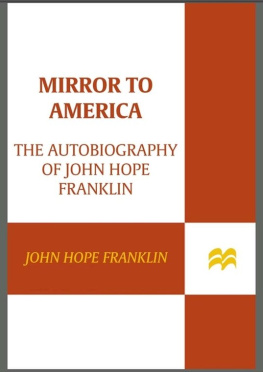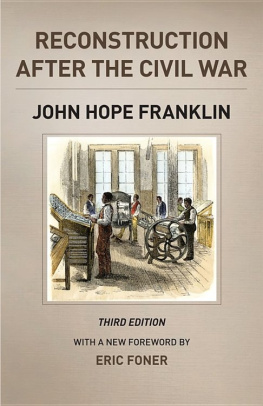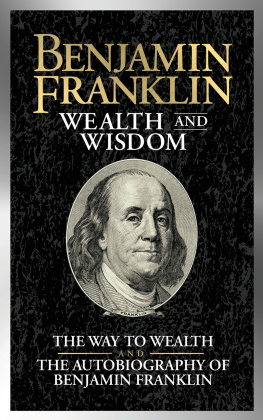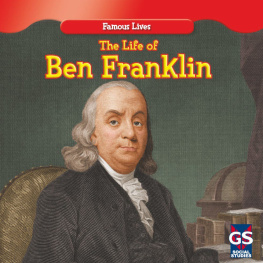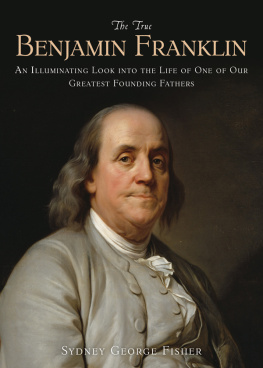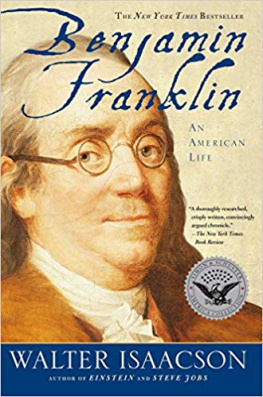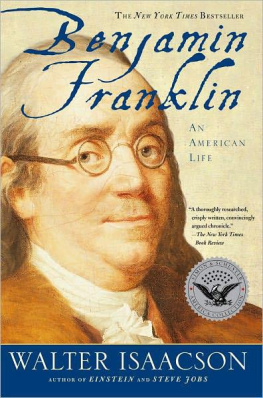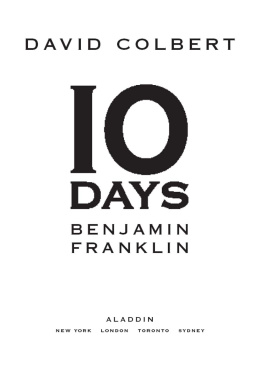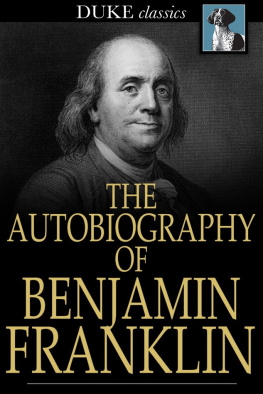MY LIFE
AND AN ERA
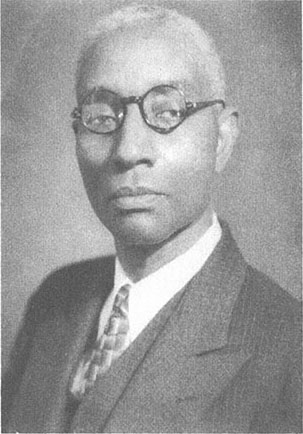
MY LIFE
AND AN ERA
The Autobiography of
Buck Colbert Franklin
Edited by
JOHN HOPE FRANKLIN and
JOHN WHITTINGTON FRANKLIN
LOUISIANA STATE UNIVERSITY PRESS
BATON ROUGE
Copyright 1997 by Louisiana State University Press
All rights reserved
Manufactured in the United States of America
Louisiana Paperback Edition, 2000
09 08 07 06 05 04 03 02 01 00
5 4 3 2 1
Designer: Laura Roubique Gleason
Typeface: Janson Text with Trajan and Hampton Script display
Typesetter: Impressions Book and Journal Services, Inc.
Printer and binder: Thomson-Shore, Inc.
Library of Congress Cataloging-in-Publication Data
Franklin, Buck Colbert, 18791960.
My life and an era : the autobiography of Buck Colbert Franklin /Buck Colbert Franklin ; edited by John Hope Franklin and John Whittington Franklin,
p. cm.
Includes index.
ISBN 0-8071-2213-0 (cloth); ISBN 0-8071-2599-7 (paper)
1. Franklin, Buck Colbert, 18791960. 2. Afro-American lawyers
OklahomaBiography. I. Franklin, John Hope, 1915-.
II. Franklin, John Whittington, 1952-. III. Title.
KF373.F745A3 1997
340'.92 dc21
[B]
97-24771
CIP
The paper in this book meets the guidelines for permanence and durability of the Committee on Production Guidelines for Book Longevity of the Council on Library Resources. 
CONTENTS
Buck Colbert Franklin: An Appreciation
John Hope Franklin
My Life and an Era
ILLUSTRATIONS
Frontispiece
EDITORS PREFACE
T he several features that impressed us as we began to work through this autobiography were the authors unswerving determination to complete it, his great anxiety to pay tribute to his mother and his wife by dedicating it to them, and his firm belief that he had something of importance to pass on to later generations. In preparing this volume for publication, we have respected to the letter the things that seemed to be of the greatest importance to the author. We have included his dedication just as he wrote it. And, believing that he had something to say, we have retained to every extent possible the spirit and the letter of his message.
Buck Colbert Franklin was no ordinary mortal. He believed to the very end that he had a destiny to fulfill. The high standards he maintained in the practice of law, his numerous efforts to serve, in a variety of ways, the communities in which he lived and worked, and his strong belief in a Power greater than any that he could behold drove him to pursue the highest and noblest goals to which he could aspire.
His writing of My Life and an Era would seem to confirm his belief that he had something to say that was worth saying. He wrote with meticulous care, as if clarity of thought and precision of expression would contribute to a better understanding of what he was saying, as was, indeed, the case. He could summon up the most remarkable detail, assisted in part by a diary, which he kept only occasionally. His memory was unusual, but it was reinforced by conversations during his lifetime with siblings, other relatives, and friends. The result was an account of a life and times that he deemed worth sharing with others. His offspring who have undertaken the pleasant task of preparing it not only agree with his objectives but are also pleased and honored to facilitate his aspirations.
Although there were times when he seemed to regard his prose as divinely dictated and thus not subject to any revision whatever, that was clearly not the case, ultimately. In the months before his death his flexibility was so great that he welcomed any suggestions for improvement. His words were no longer precious, and he almost too willingly acceded to any suggestions for improvement. There was sufficient agreement regarding the nature of the improvements as to encourage such modifications even after his death. This was done with the most meticulous care so that it would in no way detract from the spirit or the general arguments set forth in his autobiography.
In preparing this manuscript for publication, one important question arose with the editors and, indeed, with the publisher. This had to do with the propriety of reproducing the simulated conversations, just as the author provided, when it was quite clear that the time lapse made accurate reproduction of such conversations impossible. We, however, suggest that the author was attempting to convey, by using this method, what actually transpired, and we concluded that the construction of the conversations as straightforward narratives of what people talked about would be no closer to the truth than the simulated conversations. Indeed, by permitting the authors account to stand, it gave him the opportunity to provide the words and flavor of the experience which had, in turn, a flavor and value of its own.
We have sought to keep notations and explanations to a minimum. This is Buck Colbert Franklins book, not ours. We have attempted, through a limited number of notes, to assist the author in making clear to the reader what he was saying or describing. The photographs, extending from the late 1890s to 1959, the year before his death, are themselves a statement about his life and times.
Many people have assisted us in this effort. Some, like Ruby Graham, were persistent in inquiring about its impending publication. Unfortunately, Ruby did not live to see the completed work. Bob Blackburn of the Oklahoma Historical Society was generous in his time and wise in his suggestions, as were other members of his staff. Daniel Gibbs, reference librarian of the Ardmore Public Library, and other members of his staff were likewise helpful. Ernestine Clark of the Oklahoma City Metropolitan Library System put us in touch with several important sources. Robert Powers of the Tulsa Historical Society provided photographs of early Tulsa and important information regarding residents of the city. We shall be ever grateful to David A. Page for his remarkable talents that greatly improved the photographs that we used. Our nephew and niece (cousin) shared with us materials on Buck Colbert Franklin in their possession. Walter Hill of the National Archives and Record Service assisted us greatly in locating relevant sources in the Archives, as did Christine Louton of the National Park Service and Tim Good of the Lincoln Home National Historical Site. Our son and brother, Buona S. Ndiaye, assisted in numerous ways, including retrieving materials from various libraries, during which he was ably assisted by members of the staffs of the libraries of North Carolina Central University and Duke University. Margaret Fitzsimmons typed the entire manuscript and lent enormously valuable editorial assistance. Nishani Frazier typed the Introduction, Appreciation, and other matters in the final stages. We are most grateful to all who have assisted us. Our wives, Aurelia and Karen, were long-suffering and encouraging, for which we are grateful, but they do not share the errors and failings, which are ours alone.
John Hope Franklin
John Whittington Franklin
BUCK COLBERT FRANKLIN:
AN APPRECIATION
A fter my father suffered a cerebral vascular accident in 1956, he refused to accept the limitations placed on him by his inability to use his right side, including the hand with which he wrote. He had many tasks to do, he insisted, among them the writing of his autobiography. He had long been a frustrated and unfulfilled writer; and I am convinced that if he could have eked out a living as an essayist, novelist, or columnist, he would have gladly done so. With several rejected manuscripts and some unfinished ones in his files, he abandoned them; and with a determination born of the realization that his time was limited, he began to write about his own life. Once he had recovered sufficient strength to maneuver his own body, he began to write his story and thus to fulfill a dream. Day after day after day, he sat before his manual typewriter carefully and precisely typing out, with the index finger of his left hand, the story of his life.
Next page

